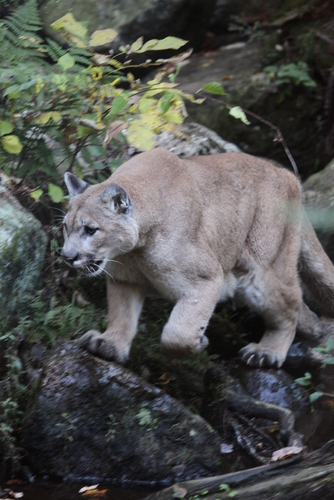
| common name | Mountain Lion |
| Also called | Puma, Cougar, Catamount, American panther |
| scientific name | Puma Concolor |
| classification | Animalia - Chordata - Mammalia - Carnivora - Felidae |
| hazard type | Man-eater |
| range & frequency | Believed extinct in the East (except Florida). |
Puma, cougar, catamount, mountain lion - all refer to the same animal. The "Florida Panther" is a member of the same species, though considered a distinct "population". With males weighing up to 120kg (264lbs), catamounts are powerful and agile predators, capable of bringing down a moose. Their mode of attacking large prey is by ambush, leaping onto their victim's back and biting through the back of the neck.
Their preferred prey is deer, but they will kill and eat animals as small as grasshoppers. Though historically seen as shy and elusive, recent experience in areas such as Colorado have demonstrated that the puma is an adaptable animal, and has lately shown new willingness to follow its prey into suburban back yards. Unlucky pets and even a few humans have been attacked and eaten in recent years.
For our purposes, before we become too concerned with the question of whether a puma is likely to eat a hiker, there is the preliminary question of whether wild pumas exist in the Northeast. Search for "cougar" or any of its synonyms on the websites of park services in the Northeast, and you will find nothing. The reason is simple: it is the decision of such authorities that wild catamounts do not exist.
It may surprise you, then, to read that most biologists who have studied the question accept that there are in fact a few cougars loose in the woods of New England. The question for them is not whether or not the cats exist. Puma sightings in New England, though few in number, have been confirmed by evidence including DNA. The question for agencies in charge of "wildlife management" is whether the cats are really "wild." Maine alone is said to have over one hundred catamounts living in captivity, so any big cats in the woods may simply be escapees, of little more consequence than emus in Arkansas or alligators in Massachusetts. So long as they are not breeding, park services do not have to implement wildlife management plans.
An eyewitness recently reported sighting a cub in Maine, but this is unconfirmed by physical evidence. Whether there are breeding mountain lions in New England remains uncertain.
To me, the question is academic. If our experience with coyote is any guide, it is only a matter of time before a true wild, breeding, population of catamounts exists in the Northeast, if it does not already. (A related question has some consequences for conservation and management but is equally unimportant to a hiker's safety: whether any present or future breeding lion population consists of true Eastern survivors, migrants from the West, escapees that have managed to breed, or some combination.)
For completeness' sake, the following advice, based on reports from California and the
Rockies, seems sound:
Do not travel alone in known puma territory, especially at dawn or dusk. Avoid running in
particular as this is thought to stimulate a chase-and-kill instinct.
Experts agree that a mountain lion charging at you is trying to eat you. Self-defense by any means possible is indicated - submission or "playing dead" is not likely to work. There are reported cases of people successfully fending off cougars with their bare hands.
I'm speculating here, but since pumas prefer to bite the back of the neck, it seems likely that a large and tall backpack could provide some initial protection. Another piece of equipment that seems worth a try against large cats is a cap with false eyes painted on the back - villagers in tiger habitats swear by it.